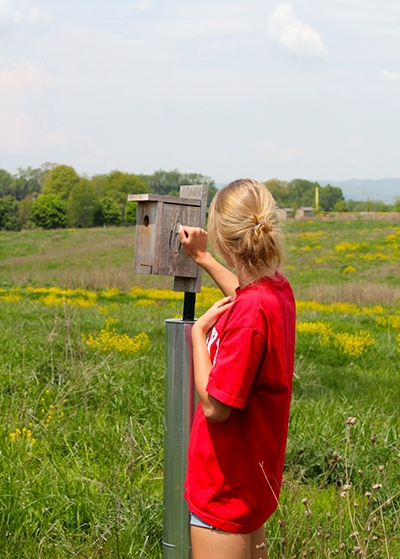Hopkins Lab hatches bluebird outreach project with Blacksburg High School
June 5, 2015


This spring, Blacksburg High School students peeked into wooden nest boxes and found one of three things: an empty nest, powder blue eggs, or best of all, a feathery baby bird.
As part of a partnership with Virginia Tech, approximately 50 wooden bird boxes were placed on a natural stretch of the high school’s property so that students can learn about bird biology, the scientific method, and environmental problems like climate change.
“The project has been a perfect hands-on, real life experience for my students,” said Steve Hulburt, teacher and science department chair at Blacksburg High School, who incorporated the boxes into his Biology I and Biology II courses. “They have been able to be outside interacting with nature, with the understanding that the work they are doing is contributing data to long term monitoring at the school. This experience is likely the one thing about high school science that they will remember for the rest of their lives.”
The students have developed data sets based on observations about the year-to-year breeding patterns of Eastern bluebirds, Carolina wrens, tree swallows, and Carolina chickadees with guidance of Virginia Tech researchers, who include Bill Hopkins, professor of fish and wildlife conservation in the College of Natural Resources and Environment and director of the Global Change Center at Virginia Tech, Glenda Gillaspy, professor of biochemistry in the College of Agriculture and Life Sciences, and David Lally, project associate in plant pathology, physiology, and weed science in the College of Agriculture and Life Sciences. All are affiliated with Virginia Tech’s Fralin Life Science Institute.
The group came together two years ago to develop the project, and Hopkins’ former postdoctoral research associate Michelle Beck was the ‘feet on the ground’ in the school system. She is now assisted by Grace Wilde, a recent Virginia Tech graduate in biological sciences in the College of Science who worked in Gillaspy’s lab. Wilde plans to pursue a master’s in education at Virginia Tech this fall, and the outreach project was perfect training ground for her teaching pursuits. Phil Beever, the high school’s shop teacher, and his students made the boxes.
Beck said that while it may take at least five years for the students to compile significant data, the team is off to a good start and have already made several observations about differences in bird breeding patterns between the first and second years.
“This project allowed the students to act as citizen scientists and hopefully they will carry that with them in the future,” Beck said. “Second, I think it provided a nice avenue to show students how changes in climate are associated with observable changes in animals that are in their backyard, not just high latitude species like polar bears and in general helped make them more aware of the challenges climate change poses for humans and animals alike.”
Initial funding for the project came from the College of Agriculture and Life Sciences, with the goal of investment in a project to engage the high school’s science, technology, engineering, and mathematics (STEM) classrooms. Additional support was provided by the Fralin Life Science Institute.
“Mutually beneficial partnerships like this are a win-win situation for everyone,” said Lally. “The exceptional teachers and principal at BHS get to provide engaging learning experiences for their students and the faculty and students of VT get to promote the learning, discovery, and engagement that are at the core of our mission. This approach allows us to achieve multiple goals with a singular investment.”
Story by Lindsay Key






